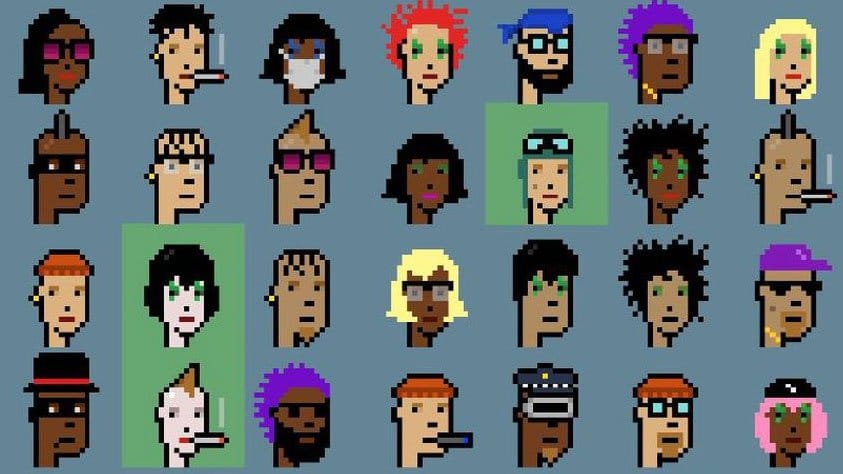Maybe you are wondering: ‘why buy NFTs?’ at all? Or, what are my opportunities in the NFT art collections market? Well, in this guide we will take you through all of the reasons to buy NFTs. From collectibles to 1:1 art pieces, each NFT has a different reason to why they exist. So, what is the point of NFTs? Let’s explore further.
To understand why people buy NFTs at all, we first need to consider what NFTs are.
What are NFTs?

Non-fungible tokens are unique digital assets that cannot be copied or altered. They use blockchain transactions to lock in certain things the NFT owner gets to keep, along with a smart contract. These things could be a piece of animated art, access to exclusive real-world events and experiences, a previously unreleased piece of music, or just about anything else you might think of. If you want to know more, check out our guide on What an NFT is!
How Do NFTs Work?
NFTs rely on blockchain technology, particularly Ethereum. They work because of smart contracts, which are self-executing agreements that record ownership and provenance data on the blockchain. This technology ensures the uniqueness and scarcity of NFTs, making them tamper-proof and verifiable by anyone. It’s like a digital notary that certifies the authenticity and ownership of digital assets, enabling the NFT ecosystem to function.
NFTs work like digital certificates of ownership for unique items in the digital world, such as art, music, or virtual real estate. Each NFT has a distinct code that proves you own the original digital item, even though copies might exist. Think of them as digital collectibles with a verified owner, making them valuable to collectors and creators.
Why buy NFTs?
The contents of the NFT itself are less important than how the tokens work. By using smart contracts, they guarantee a predetermined agreement will always be honored. So, for example, if we wanted to mint a token containing original digital artwork, this might mean 80% of the sales revenue goes to the artist, and 20% is donated to a charity.
NFT Use Cases
NFTs have evolved beyond their origins in digital art, finding applications in various industries, revolutionizing ownership, and providing novel opportunities for creators and consumers alike.
- Music: Musicians tokenize songs, albums, and merchandise using NFTs, allowing for fair royalties and direct sales.
- Event Ticketing: NFT tickets enhance security and eliminate scalping, while enabling interactive experiences for ticket holders.
- Virtual Real Estate: In the metaverse, NFTs represent ownership of virtual land, where users build, trade, and monetize their creations.
- Gaming: Play-to-earn games reward players with NFTs, which can be traded or sold, with titles like Axie Infinity gaining popularity.
- Food and Drink: The “foodverse” sees NFTs representing recipes and access passes to exclusive dining experiences.
- Supply Chain: NFTs improve supply chain transparency by recording and verifying product touchpoints, fostering ethical practices.
- Decentralized Finance Loans: NFTs serve as collateral for decentralized finance loans, though they carry risks due to market volatility.
- Art and Collectibles: NFTs revolutionize art collection, enabling direct sales, royalties, and trade in digital art and sports memorabilia.
- Fashion: NFT clothing items are collectibles and fashion statements, with major brands entering the market.
- Web3 Identification: Utility NFTs offer irrefutable proof of ownership, enhancing digital asset control and online identity in the Web3 space.
In the sections below, we take a look at how NFTs are useful for artists, builders, and collectors alike. For detailed information on NFT use cases, please take a look at our definitive NFT 101 guide.
1. NFTs for Artists
– NFTs and Royalties
Royalties are the hot topic in NFTs as of 2023. With some marketplaces rushing to cater to trader benefits, while others refrain from removing enforced royalties – the marketplace war continues to rage on. This further fuels conversations centered around how artists (and their communities/fans/collectors) continue to value their works.
Royalties are easy enough to set in place without the use of a smart contract, but it’s much harder — bordering on impossible — to ensure every time the work is resold this continues to happen. NFTs offer fixed terms that guarantee funds are distributed among all parties, for the lifetime of the token itself.
It’s a point that Jay-Z made when discussing Tidal’s NFT plans. He was talking about music, but it applies to anything with royalties. When you buy an NFT, or mint your own, you guarantee a share of the royalties will be yours, forever.
As NFT marketplaces move across changing trends in the market, some marketplaces such as Rarible have taken a strong stand against dismissing royalties. Moreover, a few no-code NFT generators also have smart contracts with in-built capabilities that allow creators to block marketplaces lacking enforced royalties.
Regardless, NFTs unlock the artists’ potential with regards to expanding and embracing more sustainable economic revenue streams. This is why NFT royalties are here to stay, and will always be a driving market force giving more power to the hands of creators worldwide.

– Digital Scarcity:
NFTs are the maestros of artificial scarcity, creating a buzz in the digital world. They enable creators to tokenize digital assets like artwork, music, and virtual real estate, making them unique and indivisible. By limiting the supply, NFTs heighten their perceived worth, drawing collectors and enthusiasts who cherish their exclusivity and blockchain-backed ownership proof.

Stoking Demand through Scarcity:
NFTs fuel demand through several ingenious mechanisms:
- Urgency and FOMO: The limited supply prompts a sense of urgency and FOMO (fear of missing out) among collectors, driving quick acquisitions.
- Blockchain Assurance: Blockchain’s immutability and traceability enhance the value of NFTs, assuring buyers of authenticity.
- Social Status: Owning rare NFTs has become a digital status symbol, increasing their allure.
Exploring NFT’s Scarcity Strategies: NFTs employ various strategies like limited editions, timed releases, and collaborations to craft artificial scarcity. Limiting editions lets creators control supply, while timed sales create urgency. Partnerships with renowned figures leverage their fan base, boosting NFT desirability.
Redefining Scarcity in the Digital Age: In an era where digital replication is effortless, NFTs reintroduce scarcity, challenging traditional economic models. The fusion of blockchain and artificial scarcity opens new horizons for creators, collectors, and investors, reshaping how we value digital assets.
– Reaching New Audiences:
NFTs offer brands an innovative avenue to engage new audiences effectively. A compelling example is “NBA Top Shot,” where fans can buy and trade NFT-based memorable basketball highlights. This unique digital collectible platform has expanded the NBA’s reach, drawing in fans and collectors while creating a new revenue stream.
Moreover, brands like Taco Bell have auctioned NFTs representing their brand elements, engaging with the crypto community and resonating with their audience. Gucci’s collaboration with Arianee verifies product authenticity through NFTs, boosting trust and customer engagement.
Charmin’s playful toilet paper NFTs and Coca-Cola’s nostalgic advertisements in NFT form demonstrate the creative potential of NFTs in connecting with audiences. These campaigns align with brand values, engage customers interactively, and support social causes, enhancing their impact.
In sum, NFTs empower brands to create unique digital assets that resonate with their audience, align with their values, and foster engagement, ultimately expanding their reach and creating memorable marketing experiences.
– Creating Artist Communities:
Beyond marketing, NFTs play a pivotal role in building and nurturing creator communities. They enable creators to establish stronger bonds with their audience by offering exclusive perks, immersive experiences, and valuable insights. By using NFTs to productize access to their community, creators transform products and services into community benefits.
This approach enhances brand loyalty, attracts partnerships, and fosters engagement within these communities. NFTs also create opportunities for cross-selling and up-selling, ensuring sustainable income growth for creators. Overall, NFTs empower creators to transition from audience building to community building, enabling enduring relationships and innovative monetization strategies.
2. NFTs for Creators
NFTs have transcended their initial association with physical art and are now a game-changer for creators across various domains. Beyond visual art, musicians, writers, and even software developers are discovering the advantages of NFTs. These digital tokens offer a revolutionary way to ensure creators receive royalties for their work, long after its initial sale.
Additionally, NFTs provide an immutable record of ownership and provenance, enhancing traceability and authenticity. This technology democratizes creativity, granting artists and creators newfound control and financial opportunities in the digital age.
– Crowdfunding with NFTs
Furthermore, NFTs also contribute to social good in a huge way. Crowdfunding plays a huge hand in NFT projects aimed at public welfare. Take for example political activist Julian Assange’s NFT projects.
The Clock NFT, a collaboration between Pak and Julian Assange, made waves in February 2022 by becoming the third most expensive NFT ever sold at $52.7 million. Despite its name, this NFT symbolically counted the days Assange spent in Belmarsh Prison on espionage charges in 2019.
It was purchased by AssangeDAO, a decentralized organization with 10,000+ supporters who collectively crowdfunded the acquisition. All proceeds were directed to the Wau Holland Foundation, supporting Assange’s legal battle, exemplifying a creator- and middlemen-free approach.
– Film NFTs
NFTs also play a crucial role in film and mass media projects. NFTs have had integrations for both the creation and promotion of films, docuseries, web series, and various other TV/entertainment projects. Infact, in 2023, we even witnessed our first ever NFT actor!
– Music NFTs

by Steve Aoki and 3LAU
Image Credit: Cryptoknowmics
Music NFTs are an up-and-coming resource for all music creators to engage and earn from the communities they’ve built. Infact, in 2023, GRAMMY nominated artist Grimes admitted she’s earned more money in NFTs than the entirety of her music career! Furthmore, superproducer/DJ Steve Aoki is also a huge proponent of web3 and NFTs.
Besides this, the NFT space has also given rise to newer levels of artistry by native musicians. Coopahtroopah has emerged as an NFT pioneer with his record label Coop Records investing heavily into NFT music. Moreover, Music NFT stars like 3LAU (who is also one half of NFT music duo PUNX with Aoki), Ed Balloon, Aloe Blacc and more continue to break new ground in the space!
– Fashion NFTs
In 2022, Alo Yoga a top athleisure brand, introduced their “Digital Twins” as NFTs, reflecting its 2022 Aspen collection. These NFTs correspond to real-world clothing items, offering buyers exclusive real-life perks, including fashion week access and personal training sessions. Developed in partnership with Digital Twin Studios, this initiative aims to seamlessly integrate Alo’s community into the web3 space while simplifying the process for users.
Moreover, even legacy brands such as Gucci, Louis Vuitton, Crocs, and more have also expanded their interests and products across NFTs and the metaverse. Furthermore, NFT brands such as The Fabricant have also made their way into coonsecutive New York Fashion Week events in the past few years (including 2023)!
5. NFTs for Collectors
– Traceability and Transparency:
You can also rest assured nobody else owns the NFT, or its content, because by nature they are entirely unique. A non-fungible token is a bit like a digital signature, and we all know the significance of a John Hancock on physical works of art. And, even if the contents themselves are not one-off, the token is. So you can trace exactly where it came from and when, effectively removing the risk of fakes.
From the perspective of some in the traditional art world, the idea of buying digital artwork that can’t be framed and hung on the wall might seem strange.As such, the thought of being sold a fraudulent digital artwork sounds even weirder. But this discounts how much value has been created by NFT art collections.
Take for example Americana’s phygital vault platform that combines physical asset storage with digital NFT replicas. This offers a unique solution for Web3 users. Users can securely store a wide range of items, from vehicles to stamps, in high-quality vaults.
What sets Americana apart is that each physical asset is linked to an NFT, enabling trading and showcasing in the Web3 space without the need to physically move the items. The platform offers tailor-made plans for asset storage and utilizes modern fingerprinting technology for authentication, even on artworks.
Americana Vault is gaining popularity among collectors and is making blockchain technology practical and accessible for everyday people.
– Digital Twins:
NFTs also grant access to new mode of in-real-life applicability. Some of these examples are as follows:
- Real Estate: NFTs enable secure and immutable representation of real estate assets. Beyond buildings and land parcels, NFTs could digitize intellectual property rights, conservation areas, and 2D/3D art within properties. This opens the door to a wide range of digitized real-world assets.
- AI and Data: NFTs are used to tokenize AI models and data sets. Beyond trading, these tokens could facilitate secure sharing of AI services, knowledge, and innovation across various sectors like healthcare, agriculture, and finance.
- Physical Goods: NFTs can represent physical collectibles and items. This tokenization allows for fractional ownership, which can democratize access to valuable physical assets. Examples include fine art, vintage cars, or rare memorabilia.
- Education: NFTs offer tamper-proof credentials, which can be especially beneficial in education. Beyond this, NFTs could potentially be used for digital textbook ownership, course materials, or certifications, enhancing the educational experience.
– Authenticity:
NFTs are also powerful digital certificates of authenticity in the art world. These tokens make it easier for galleries and museums to safeguard their collections.
Unlike traditional certificates of authenticity (CoA), NFTs offer robust, tamper-proof records of ownership and metadata. The innovation lies in their potential for more than just ownership verification. NFTs can include detailed instructions for storage, conservation, and exhibition of artworks.
Beyond art, these tokens could redefine how museums manage their collections. By integrating with existing Collections Management Systems (CMS), museums can enhance data security and interoperability, ultimately benefiting researchers, conservators, regulators, and curators. The adoption of industry-wide standards like the Art ID Standard could streamline processes, protect against fraud, and open up the art world to new possibilities.
NFTs are pave the way for a future where digital certificates of authenticity are more accessible, secure, and transparent, revolutionizing the arts and culture sector.
6. Buying NFTs Can Make You Serious Profit
For example, take the Cryptopunks. Naturally, the rarer the punk the higher value the token is likely to sell for.
Cryptopunks are “blue-chip NFTs”. Basically, they are special collectibles that are more popular and more in demand than most.
While ‘CryptoPunks’ may outprice some, we can learn a lot from their history. The collection first landed in 2017 and, crucially, all tokens were originally given away for free.
Yep, despite being the first free mint, Cryptopunks are now worth close to $100k. How’s that for a profit? The point is, for most people the real opportunities in the NFT art collections market are the same as those in the real world art market. If you can spot something valuable before everyone else does, you’re on to a winner.

7. Bragging Rights
Lots of NFT collections give exclusive benefits to their holders. Think of VeeFriends, Doodles and Bored Ape Yacht Club! These collections hold both metaverse and real life events to entice their community into engagement. Essentially, these pfp NFT collections act like brands. What better way to flex your portfolio than an expensive profile picture and matching merch?

8. Community

Obviously, a great reason to buy NFT art is community. Almost every NFT project these days boasts a unique community experience. The film3 collective have a range of different NFTs for movie-loving NFT heads. Check out our interview with Migel Faus about his film calladita, and our interview with Jordan Bayne about Red Flags to find out more.
On top of that, there are also 1:1 art communities, the NFT spirits community and countless other NFT communities to get into. Just search for your interest and there is almost definitely an NFT you can buy to get stuck into a new community.
In conclusion, there are plenty of ways to get involved with NFT art. Whether you want to buy NFTs to join a community or you just want to have better transparency in your business, there will be an NFT for you.
All investment/financial opinions expressed by NFTevening.com are not recommendations.
This article is educational material.
As always, make your own research prior to making any kind of investment.








